1
The Stopping HouseBuck Smith's Stopping House opened in 1879 when High River was called "The Crossing". People would stop here to rest and refuel before crossing the Highwood river and continuing on their journey on the old Macleod Trail.
The Stopping House was the social centre of the area. Dances were held as often as possible, and people would come from far and wide to attend. The music was impromptu - sometimes an accordion player was rounded up, sometimes a violinist, or even an expert on the mouth organ. Quadrilles, waltzes and polkas were performed with enthusiasm by adults and children.
People had to walk or ride to the dance so they would last until the sun came up when the party goers could make their way home in the daylight.
2
Buck Smith's Stopping HouseCirca 1891
High River, Alberta, Canada
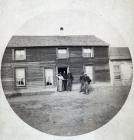 Credits:
Credits:Museum of the Highwood Archives 967-010-037
3
Bavis HallIn the late 1890's Bavis Hall was built near the site of today's Memorial Centre. The origins of the hall are unknown, but there is a 1901 photo of teacher "Boots" Bavis with his class and it is assumed that he is the Bavis of Bavis Hall.
Bavis Hall was the venue for various traveling performers. Unfortunately, the talent this venue attracted often lacked in quality. The town citizens were quick to respond. Poor performers were pelted with eggs that, the audience insisted, were freshly purchased from The High River Trading Company and were not rotten as one show producer claimed. One poorly received troupe was driven out of town during a rainstorm and had to walk the railway tracks all the way to Okotoks.
Egg-throwing as a popular means of displeasure with performers disappeared when the town finally aquired a more upstanding venue in the new High River Town Hall - The Opera House.
4
The Opera HouseIn 1906 High River opened its very own opera house. It was simply named 'The Opera House' and was located on the second floor of the Town Hall. After more than 40 years as the cultural centre of High River, it was torn down due to disrepair.
The first play staged in the building was 'Uncle Tom's Cabin'. Traveling theatre companies, of various quality, kept the theatre busy. The Opera House housed not only operas, but also plays, a variety of music concerts, school concerts, political rallies, fairs, dances and parties. Occasionally a famous singer or well known theatre group would be lured to High River. On these nights The Opera House would be literally "jammed to the rafters."
Compared to it's predecessor, Bavis Hall, The Opera House was a much more respectable venue. However, the High River Times reported that it wasn't without its problems. Because The Opera House was in the same building as the Town office, jail, and fire hall, there was an occasional mishap. One story describes a little bit of "excitement" accidentally added to a formal ball. One night, the fire brigade returned from fighting a fire in minus 28 degree weather. When the men saw a half-boiler of coffee on the stove, they assumed it had been brewed for their benefit. Deciding to add a little more "warmth" to the mixture the men dumped six or seven bottles of gin into the mix. Unfortunately, the coffee had been made for the ball and shortly after being spiked, it was taken upstairs. Apparently the party picked up quite a bit after that.
When the Town Hall finally closed its doors for good, the High River Times wrote: "Recollections of all the frivolity, comedy, uplift, drama and tragedy ... would fill a volume. Today the Memorial Centre is our pride and joy. But it will take a heap of living before the Memorial Centre will chart up as colorful a chapter of our history, as the outmoded old Town Hall."
5
High River Town HallCirca 1913
High River, Alberta, Canada
 Credits:
Credits:Museum of the Highwood Archives 999-037-029
6
A group of performers on the stage of the Opera HouseCirca 1920
High River, Alberta, Canada
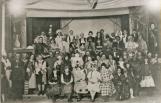 Credits:
Credits:Museum of the Highwood Archives, 979-026-015
7
High River choral society members on the Opera House stageCirca 1929
High River, Alberta, Canada
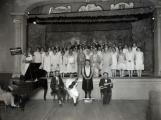 Credits:
Credits:Museum of the Highwood, 988-097-008
8
Student dance at the Town HallCirca 1940s
High River, Alberta, Canada
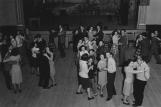 Credits:
Credits:Museum of the Highwood 007-024-009
9
The Elk's HallHigh River Elks Lodge, B.P.O.E. No. 120, was organized in 1925. Club room space was leased on the second floor of the Cornfield's premises. The lodge used the space, and allowed it to be used by other organizations, for fundraising banquets, concerts, dances, and meetings. Perhaps the space was overused because, eventually, the room was considered to be unsafe for large crowds.
10
Lane and Emerson BlockCirca 1907
High River, Alberta, Canada
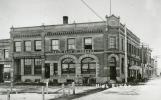 Credits:
Credits:Museum of the Highwood Archives 978-056-040
11
Many musical events took place in hotels and resturants.The High River Times reported in 1905 that the "presence of a pianola at the Saratoga Cafe renders sweet music while you enjoy a sumptuous meal" and "Saratoga cafe hosted a festive social function last Thursday evening. A dance was provided with Miss McKeage as pianist and F. Tuck, violinist."
12
Invitation to a social evening in the Saratoga Cafe21 December 1906
High River, Alberta, Canada
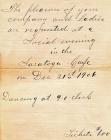 Credits:
Credits:Museum of the Highwood Archives 973-014-016
13
The Saratoga Cafe20 Century, CIrca 1906
High River, Alberta, Canada
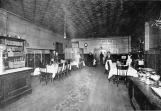 Credits:
Credits:Museum of the Highwood Archives 002-047-002
14
Alberta HotelCirca 1907
High River, Alberta, Canada
 Credits:
Credits:Museum of the Highwood Archives, 978-056-017